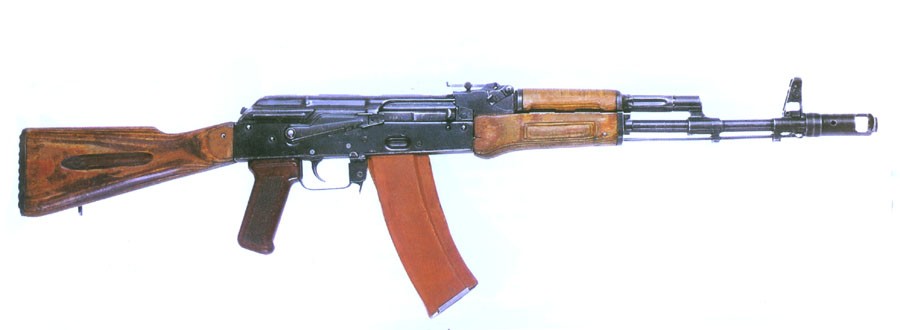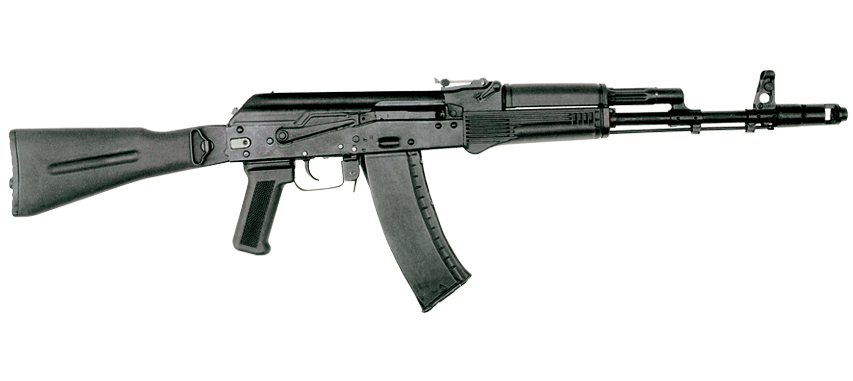Most Recent News


Popular News




AKs have a long and interesting history. What are the differences between AK-47 and the variants? Let's talk AK-74, AKM, and more.
The AK (Avtomat Kalashnikova) is my favorite rifle of all time. The most famous (The AK47) was invented by Mikhail Kalashnikov in 1947. However, there is one rifle that he invented before the famous AK47, but we’ll get to that below.
These guns are unbelievably reliable. They are also simple to clean, maintain, and fire. And on top of that, AKs come with the added bonus of also being relatively inexpensive.
As Kalashnikov put it himself:
I wanted to invent an engine that could run for ever. I could have developed a new train, had I stayed in the railway. It would have looked like the AK-47 though (laughs).
Mikhail made these guns for moderate distances and close quarters fighting, being accurate up to about 300m (originally). Many good-shots can shoot them much farther than that, but the design specs specifically point toward 300m.
The original AK design has been cloned by many countries, such as China/Bulgaria/Romania. However, despite the differing types of AKs and their cloning, the media tends to just refer to every assault rifle as the infamous “AK-47”.
I hope that this article will clear up any misconceptions about them and showcase the widespread differences between the variants.
The image below is of the AKM. However, most of the internal components in these rifles are the same throughout the years from 46 to 100. So (for the most part) it will reliably identify parts of the rifle, regardless of which type of AK we’re looking at.
(NOTE: All images can be enlarged. Click on image, or right-click “View image” to enlarge)

The AK-46 was Mikhail’s prototype that would later be developed into the AK47.
It was, as the name implies, originally designed and sought review in 1946.
This first AK rifle was chambered in 7.62x39mm.
The AK-46 had two variants (for a total of 3 generations) created. The second generation of the AK46 was the most important to the addition, however, because it removed the bolt carrier from the outside of the rifle (making it more reliable), while simultaneously refining the prototype to provide the “smooth” shooting we’ve known to come and appreciate from AKs.
An example of the second generation AK-46 is pictured below:

The third generation of the AK-46 didn’t really change anything meaningful besides the stock.
It came with the inclusion of an under-folding buttstock, which has been incorporated into certain variants of all future AKs.
A piece of interest with all AK-46s are that they are short-stroke weapons. Most of the ones we know are long stroke (even the AK-47 implemented long-stroke, so this is the only version that is short-stroke).
If you’re curious about the differences between the two, this article really explains it well. TL;DR: Long stroke is generally better and is definitely better for AKs.
Check out the field strip for the AK-46:

A good prototype, but I doubt you’ll find anyone that complains about her upgraded version, which is of course:
One of the single most important weapons of modern history. Its legacy lives on today, as it’s still one of the most widely distributed and known weapons.
This upgrade of the AK-46 comes with a lot of improvements, here’s just a few:
It still used the same cartridge, the 7.62x39mm. As the name implies, it was approved in 1947 and began its widespread distribution in the same year.
Here it is:

This gun went through a lot of later changes. We’ll go through the transitions in order:
Number 3 above, whether you call it the final version of the traditional AK, the AK48, or just “The AK”—it all means the same thing.
But that variant also has a fourth name: Type 1. It’s the first in the variant series of traditional AK’s, since it was the first introduced en masse to the Soviet military.
The Soviets continued to edit and change the AK over the course of the next decade, but never renamed it. So we refer to them by their Type, as in Type 1, Type 2, Type 3. This helps distinguish the differences between the AK-47.
Here’s the breakdown:

The Type 2 is on top.
The Type 3 is on bottom.
If I hadn’t told you, could you tell the difference? There are a few specific pieces that give it away.
This is a pretty common variant of the traditional AK. It stands for “Avtomat Kalashnikov Modernizirovanniy”, AKA: Modernized AK.
It was approved for full production in 1959. By this time, the Soviets had the mass production capabilities post-war, allowing these to be made en masse.
The scientists behind the new developments built them off of the Type 3 AK-47 model.
The changes (improvements, by some standards) are numerous, including:
The AKM is also the most widely used AK variant in history. It spawned a ridiculous number of other variants from it, probably over 40 in total around the world. The gun has been used on every continent and is widely deployed in previously declared Warsaw Pact countries.
Here’s the traditional AKM:

As mentioned above, it created a number of variants. I couldn’t possibly attempt to address them all, but I’ll give you a list of the more common ones here:
Based on the AKM designs, this variant finally changes the cartridge to 5.45x39mm. Because of this, all the internal parts were changed slightly, to incorporate the new cartridge efficiently.
As you can probably imagine if you have read this far, this was designated “AK-74” Because it was an AK made in 1974. Surprise, surprise.
Overall, the changes were minor. It was a modernized version of a modernized version of the AK. They did change the magazine receiver, so the old magazines could not fit in it correctly (it’d be the wrong type of ammo anyway).
It also featured improved front sights, a thinned bolt (for unlocking the bolt), and a 90-degree gas port to reduce port shearing from prolonged firing
They incorporated a lot more plastic instead of metal into this rifle (such as the magazine and the pistol grip), and some later versions of the AK-74 use entirely polymer furniture.
It also has a nice lineup of offspring, including:
All of which have other small changes (such as stocks/shorter length/changed furniture/rails).
With the combination of the muzzle brake and the smaller round, the AK-74 is one of the lightest-recoil rifles in history. And likewise, the full-auto feature was incredibly easier to use as well.
Here is the AK-74:

I know this is a variant of the AK-74, yet another modernized version of it, but I have to put it in its own section.
It would be unjust for me not to. The firearm designers looked to this weapon to build upon the newer versions.
This upgrade featured a default inclusion of the optics rail, and the hinge-centric buttstock mentioned above. The AK-74M became the official infantry weapon of all Russian military branches in 1991, and continues to serve today, which is yet another why I can’t leave it out.
It also has all black furniture, making it look like a mobile tank:

Don’t be fooled. This gun is an AK-74M clone-copy. The only difference is that it is chambered in 5.56x45mm NATO, and the barrel, receiver, and magazine have been re-sized to fit the new ammunition.
This was done so it could be the AK version that could be more easily exported, as the 5.56 is the standard ammunition in many places around the world.
But it was the first of the AK-100 series. And they did have some cool advancements I’d like to mention:
See a traditional (AK-101) one here:

Finally, we’ve reached the most recent AK. This new firearm brings a lot of changes to the inner workings of the AK and has two variants as of this writing: The AK-12 and the AK-15.
The AK-12:
The AK-15:
Here is the AK-12:


And the AK-15:

As you can tell, the line of AKs have had a long and sometimes confusing history.

They have regularly switched between different types of ammo, levers, and internal parts, but the AK line has kept the general look and reliability of the weapon a high priority.
While the original AK (AK-46) never made it mainstream, her children (AK47, AKM, and AK74) sure did. They are some of the most well-known weapons, and have become some of the most prolific weapons of all time.
And the next time someone refers to a weapon as an “AK-47“, feel free to school them and tell them what the gun actually is. Because more often than not, it’s not a traditional AK-47.
I hope you found this useful. If you have any questions, leave them in the comments below.
There have been a couple of reoccurring questions since I first published this article. So I’ll make a quick announcement to clear them up.
1) What about the common US AKs? Aren’t they AK47s? Which do you recommend?
The most common AK in the U.S. is the “WASR 10 GP“. It is not an AK47. It is a post-ban version of the AKM. GP stands for “general purpose“. It is made in Romania.
The N-PAP is also popular, but it is really a standalone made by Zastava in Serbia. It’s more of its own creation, but if one was going to compare it, I’d put it next to the AKM category as well.
Neither the N-PAP nor the WASR 10 is “better“, per se. It depends on personal preference. I would chose a WASR 10 over an NPAP any day for any reason, but I may be biased, so take that with a grain of salt if you’re looking to buy one. I’m not here to review them. They are both exceptional guns but I just prefer my WASR.
2) How the heck do you keep that dang gun clean?
Yeah, they are incredibly messy. I think the AK rifles are just made to become an abyss of blackness after a single bullet. It’s how they like it. Embrace it.
Feel free to leave more questions/discussion in the comments or just send me a message. And many thanks for stopping by.
If you enjoyed this article, bookmark the website and check back often for new content. New articles most weekdays.
You can also keep up with my writing by joining my monthly newsletter.
Help fight the censorship – Share this article!

Comments are closed.
(Learn More About The Dominion Newsletter Here)
Sick article man.
So which AK version do you like best?
Thanks.
I like the original AK47 advanced Type for collectors purposes. As far as shooting, I have a WASR 10 Romanian (Which is a version of the AKM) that I absolutely love (it was cheap, wouldn’t be my first choice otherwise).
I would do some crazy stuff to get my hands on an AK-15 though. From my research, that thing seems unbelievable.
Haha that’s crazy I actually have a WASR 10 myself. Had one from before they fixed the TAPCO trigger so I had to go thru and install if myself
Yeah I got the more recent one that already had the TAPCO installed. Don’t blame you for switching it out, heard that trigger could be an absolute pain.
I never knew one of AK’s had a grenade launcher holy crap that would be awesome
What will you advise for the loads of AKM donated by Russia to the Philippine Government?
I would advise they use them to dismantle the ISIS-linked groups trying to take control of half of the country
Very good article to disambiguate the various AK variants. I get seriously irritated when the media refer to AKMs and AK-74s as ‘AK-47s’.
What do you think is the best quality non-Russian AK variant? Do they come from the former East Germany, Romania or Bulgaria? Do you think the Iraqi copy, the Tabuk, is a good build?
Appreciate it. I also get annoyed when the media calls everything that looks scary an “AK47”. That’s what initially drove me to write this.
It’s interesting you ask that question about which I think is the best quality. Everyone tends to have a really hard-line opinion on that question. In reality, it can be pretty subjective. Best as in longevity? Best as in build quality? But in my opinion, I think it’s the same for any answer. I may be a bit biased in that regard, but I’ll explain.
I think the Bulgarians make the best, hands down. Pretty much all AK variants made post-Kalashnikov’s manufacturing spree were made in the bloc countries. Bulgaria and Romania were two of the biggest. But the ones made by the Bulgarians were the one’s the Soviet military personally used, usually leaving the Romanian style for export or other purposes. It’s also pretty well-known that the Bulgarians tend to use much better input parts into the rifle. Whether this makes a sizable impact or not on the end product, I’m not sure. But they have better access to the original manufacturing components. There was also a study done by a Russian firearm manufacturer that pitted the two against each other long-term, and I remember reading the Bulgarian version did outlast the Romanian build. I’ll try to dig it up and see if I can link it to you. East Germany would be a close runner-up. Romania third (which is still miles and miles ahead of other manufacturing countries such as Poland/Albania: Look up the massive failure that is the Kbk wz. 1988 Tantal if you’re ever curious how bad an AK can be).
Regardless of which bloc country you’d consider, I think they are all better than domestic. Any AK built and assembled in a post-communist countries factory is going to be of a much better variety than domestic. Since you seem to know a deal about the AKs, I’m sure you already knew that though.
As for the Tabuk, it’s not a bad rifle. It’s built more in-line with the RPK/M70, however. So it is incredibly similar to the AKM, but I think it shares more traits with the M70. Most barrels weren’t chrome-lined, and it had a different style 1.5mm receiver. From most people I’ve talked to about it, the Tabuk doesn’t seem to be much more than a fixed-stock M70. Because of the Iraqi war, most modern Tabuks have scopes on them (and are only semi-auto) but I mean other than that, there isn’t a whole lot of differences. The sniper version does not have a gas regulator valve though, which I always thought was weird. Would be cool for collectors purposes, but if I was going to spend money on the “best” AK variant for whatever purpose, I would personally go elsewhere.
WOW you for sure know nothing of AKs if you think that Bulgarian ones were used by Russian military or Tantal was a failure. Bulgarian/Romanian are considered worst, period. Same for east Germany. Best ones would be probably from Russia made by Izmash, second from Poland. You are for sure from USA and know next to nothing about AKs besides one imported to USA.
And you know nothing about reading comprehension. I was replying to a comment discussing the “best quality non-Russian AK variant” – so obviously Russian made arms are not included. He asked specifically about East Germany, Romania or Bulgaria. On top of that, the original Tantal I was discussing isn’t even sold anymore. As for your comment about Bulgaria, the Soviets used theirs often so that’s just as wrong as everything else you wrote. Try again next time.
A friend has a Chinese AK47??? for sale. I’m not up on this rifle at all but always thought that the 47 was in a different caliber than 5.56mmx45 and this is what is on the side of the piece. Here is what I could find printed on the side of the rifle: in a triangle were the number 66, the number 845-1 and what looks like a S/N 324***, NORINCO, Made in China, 5.56mmx45, CSI LA CA. He also says it is a preban rifle. Me? With it being a 5.56, I’m thinking, unless the Chinese modified it to the 5.56, it is a AK74. HELP!!!! Maynard
That’s some limited info, but I can try to help.
More than likely, it is not an AK47 or a AK74 but a Chinese AKM variant.
Almost all Chinese imports have the triangle 66 (meaning they were made in State Factory 66, which is/was their main factory) along with the Norinco (China North Industries Group Corporation – the ones that make the guns).
CSI LA CA is China Sports International, out of Los Angeles, California. AKA: The importer.
It sounds a lot like a Type 84S from what you have said here (however, I could be wrong). And a 84S was the Chinese 5.56 version of the Russian AKM (later gen). They made these in .223 and 5.56, the most common imported in the US being the 5.56.
I think the “845” you are seeing is actually a 84S, it just may be worn. I’ve never heard of 845. (again, could be wrong here). The 84S-1 is just a version.
For additional info: Typically postban rifles would have thumbhole stocks. If it says “84S” on the trunion next to the 66 it is a preban rifle.
Hope this helps. If this doesn’t help, send me an email and I’ll get in touch with you (and ask for a pic) then I can figure it out for sure. Good luck.
Thanks for the info and the help. . This rifle does have a fold under stock not a thumbhole and the 84S is right next to the 66. I have a couple shots of the piece and would like to send them to you. Maynard
Send me an email through my contact form by clicking here. Then I’ll ask for the shots.
For anyone who may stumble upon this later on, I managed to help figure out what the AK was so I figured I’d post my response here for any inquisitive minds:
“Yep that is the fold under stock and exactly what I was picturing, and the .223 ammo definitely confirms that.
For comparison, you can find a version of it on gunbrokers by following this link. A non-polytech version is also here.
It is a 84S-1, specifically.
The 84S-1 line are called “Type 56 Assault Rifles”. Particularly, you are looking at a Type 84S-1 – A civilian version of the Type 56 rifle chambered for the 5.56/.223 round.
The 84S was originally an AK-47 copy. HOWEVER: our pic is a 84S-1, which means it is a version of the AKMS – so AKM (S just stands for folding). The first gen of the 84S-1’s were based off of the AKS, but if you had one of those it would show a NASD in the picture you sent, which it doesn’t.
So, to summarize: That is a 84S-1, Chinese clone of AKM.
Looks to be in pretty good condition, collector edition – bet you could easily get $1000 off of it. Prob normal sale range is in the $1150-1500 range. Put a cheap bayonet on the rifle and up-charge it”
There we go. Hope it may help someone else out.
Stampedes do not carry bolt-actions.
Didn’t Obama ban 5,45×39? Or is it back?
It was banned from import. Companies are only banned from importing 7N6. A lot of foreign commercial ammo is not steel-cored, so it’s fine. Tula sells it all over online, you can find it on many websites. Handloads (using reformed .222 or .223 brass) are are also legal, depending on state.
Sick article! Enjoyed every bit of it.
Thank you, glad it was an interesting read.
You forgot to even mention the maadi AK and the pre and post ban changes in them like the thumphole stock and two diffrent barrel lenghts
The title of this article is “Differences Between AK-47, AK-74, AKM, AK-101, and AK-12” – not “Discussion on every one of the 5000 duplicates of the Russian AKM”. I put in a few notable ones, but I don’t feel the Maadi is special because it’s practically a copy of the Russian AKM… it’s just made in Egypt. The people that made them were literally trained in the Soviet Union on exactly how to make them. The factory in Egypt was even run by Russians in the beginning.
Same logic applies to pre and post ban. It does not change the actual differences between the AK’s – because every AK has to comply with the pre/post ban requirements. On top of this, most of the pre-ban ones are grandfathered in anyway. It mostly only deals with imports or with lame states. I live in a free state, so it’s not super relevant on my end.
I may make a followup article to include these issues, but they definitely don’t belong in this one.
How do you feel about where Maadi lands quality-wise compared to others? Managed to come up on a matching numbers kit with folding stock. Looks like it was never used, just cut and then sold as a kit.
This guy goes into much more detail than I would ever be able to cover: https://www.youtube.com/watch?v=ruPE4oFSXbI
Going real niche mentioning the akmsu haha. Love the article, would love to see one on how to differentiate romanian, bulgarian, serbian, chinese etc. versions
Excellent article!
I learned a lot!
Thank you!
Glad you enjoyed it. Have a good one.
Спасибо, давно искал
Any update to cover the SLR variants?
Hi, man. Just so you know, It’s Avtomat Kalashnikova, not Av. Kalashnikov. You can’t simply drop a letter from the gun’s official name. Kalashnikova means “Kalashnikov’s” in russian. By the way, you might want to update the picture of the AK-12. The original prototype wasn’t accepted into service – the one they accepted looks exactly like the AK-15 (minus the mag, becouse it is chambered in 5.45×39).
Shephard, thanks for the two catches. I have updated them.
Hi
I was searching google to find a good article to how visually distinguish between AK-47 & AK-74 and maybe other variations too.
The pictures u put here are nice and easy to distinguish but in Syrian conflict as these weapons are manipulated a lot in stocks, forgrips and etc, it’s hard to distinguish sometimes.
AK-19 (5.56×45 NATO)
Excellent article, the link to which I shall re-post among those who will be interested.
One tiny grammar-Nazi point: it’s “muzzle brake” not “muzzle break”.
And a major point: we need to organize. We need to have, literally, hundreds of thousands of people organized into thousands of local groups.
Now … it would be desirable if as many of those people had the same weapon, for obvious reasons. And that weapon should be, in my opinon, the AR15, “America’s Rifle”.
Yes, yes, yes, yes … I know that 25 people here will be able to write convincing essays about the superiority of the rugged AK47, and its heavier round, over the AR15.
But we must not let the best be the enemy of the good.
I don’t know the statistics on ownership of the two, but I bet the AR is far more widespread than the AK, about ten million being owned in the US now.
And it has one advantage over the AK: it’s lighter. And we want to be able to recruit, arm, and train people who are NOT gun-enthusiasts and who are afraid of recoil, which the AR has less of.
Both are adequate … and if I could magically make everyone have the same weapon, and then make them have new recruits buy that specific type, I would choose the AK, ,mainly because it’s cheaper, and this might be a major consideration for many people, especially those who are not going to be active members of a neighborhood defense group, but sympathyzers of such a group– its reserves, so to speak.
But we are where we are, so we should recommend that everyone who does not yet have a serious weapon for SHTF situations should standardize on the AR.
Note: obviously, this doesn’t mean you should throw away your own AK. And for that matter, in a really professional organization, each squad or equivalent would have a sniper, probably using a bolt-action rifle, who would put in a lot of time learning how to use it effectively.
But for your grandmother … it should be the AR.
Postscript: on another site I look at, similar to this, people got into an argument about what sort of small ‘walkie-talkie’ type radio a neighborhood defense group should supply all its members with. One very knowledgeable fellow recommended a rather expensive, but very good one — I don’t recall the cost, but it was significant … maybe $250? … But others argued for the very cheap BaoFeng model … on some sites you can get them for $8 each if you order 20 or more … and it seemed to me that they had the better of the argument.
Yes, perhaps the main leadership of a group — the commander and sub-commanders — should haver the really reliable, longer-distance expensive ones. But if you want something that everyone can afford, go for the cheapo BaoFeng. Buy a few extra so if one of them goes US during an action, you can toss it away and be issued with another.
Agreed on many points. Thanks for the writing catch. It has been corrected.